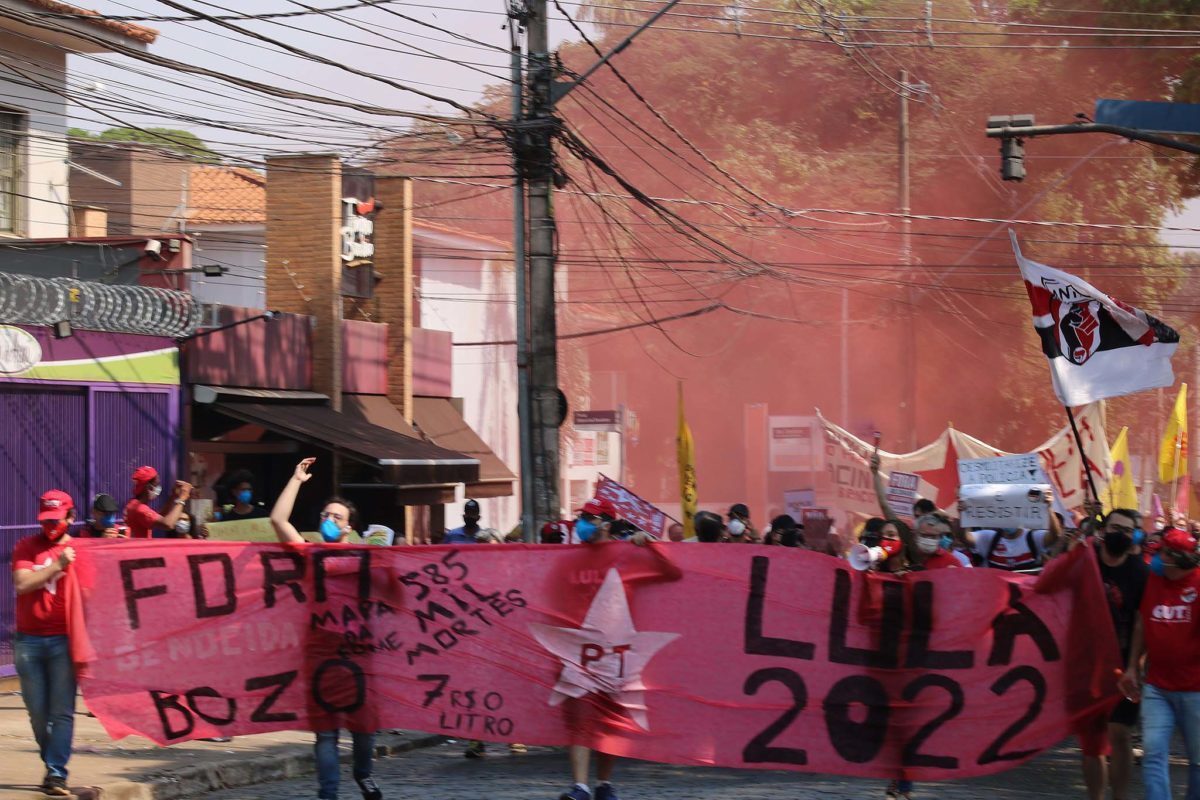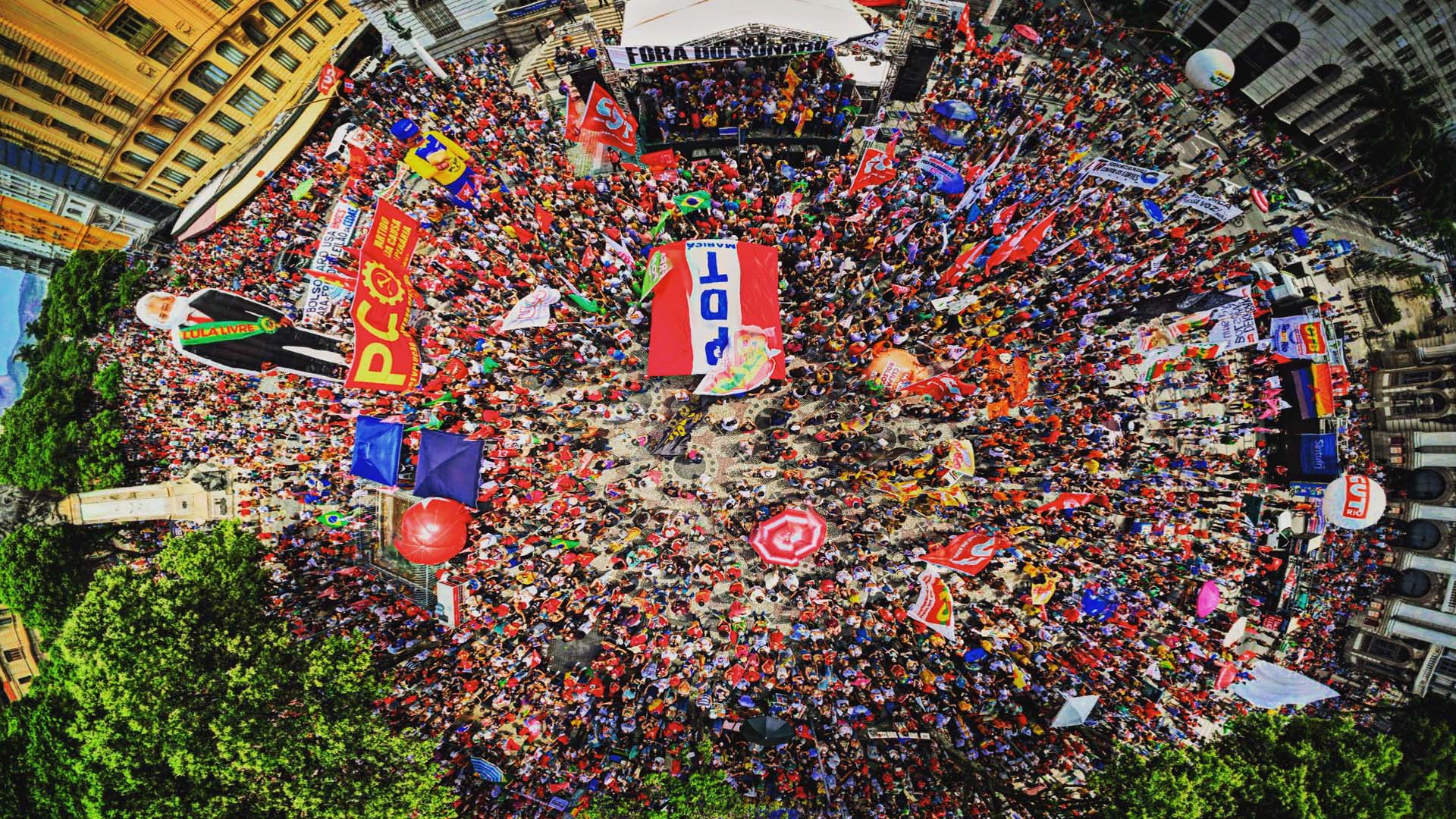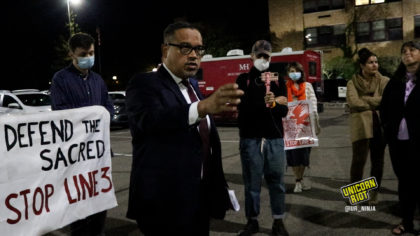Brazil: 600K Deaths, Emergency Aid Ends, Protests Continue, & People Call for Lula 2022
Just over a week after President of Brazil Jair Messias Bolsonaro’s speech at the 76th United Nations Assembly on September 21, 2021, hundreds of thousands of Brazilians returned to the streets to request the immediate removal of Bolsonaro and his administration. As Brazil passes 600,000 coronavirus deaths and continues through a controversial presidency rife with investigations on mismanagement and scandals during the pandemic, the population continues to protest the incessant rise in the price of gasoline and food, and the reduction in government assistance.
Latest – Brazil: Mutual Aid During COVID-19 and Bolsonaro’s Mismanagement – Sept. 19, 2021
Over 21,556,000 people in Brazil have tested positive for COVID-19 and as of October 8, 2021, at least 600,708 have died. The death toll is inconsistent throughout the country, with some states having staggeringly high rates, and others having low rates. While Acre is the state that’s registered the lowest number of lives lost with 1,839 out of 87,940 positive cases, three states located in the Southeast region of Brazil lead the country in deaths caused by the coronavirus.
- São Paulo: number of cases – 4,378,139 | number of deaths – 150,630
- Rio de Janeiro: number of cases – 1,293,949 | number of deaths – 67,029
- Minas Gerais: number of cases – 2,155,777 | number of deaths – 54,944
- Paraná: number of cases – 1,524,696 | number of deaths – 39,471
After a slow start mired in controversy and scandals around vaccines, the country is slowly becoming immunized with 46% of the adult population receiving two doses.
However, poverty is increasing in the country as the Emergency Aid of R$600 reais a month per person (equaling around $110 USD, not the $800 USD said by Bolsonaro at the UN Assembly) that started in the beginning of the pandemic expired in September. Although it was incredibly needed, many Brazilians who were left without work from the pandemic found that the distribution wasn’t enough. With the aid expired, the Bolsa Família (family allowance) program replaces it to provide financial assistance. Yet this has been downgraded to range from R$150 to R$375 based on points of social vulnerability.
In March 2021, Brazilian artist, Celião, told Unicorn Riot there’s no “effective sustenance for families and the population is searching for solutions.“
Expressing their dissatisfaction with the government’s mismanagement of the coronavirus pandemic, Brazilian protesters have organized to show their resistance en masse continuously throughout 2021. Responding to the national campaign of ‘Fora Bolsonaro’ (Bolsonaro Out) by trade unions and left-wing political parties such as the PT (Workers’ Party) and the PSOL (Socialism and Freedom Party), protesters amassed in Brazil on September 7 and October 2.
The day Bolsonaro organized a rally in the Capital city, which was two weeks before his U.N. speech, thousands of Brazilian protesters participated in another anti-government demo called #7SForaBolsonaro. The ‘Bolsonaro Out’ protest occurred alongside the 27th annual Grito dos Excluídos (Excluded Cry), a movement carried out since 1995 to counter the official demonstrations that mark the day on which Brazil’s independence from Portugal is commemorated.

In the city of Ribeirão Preto, a city in the interior of São Paulo, the protesters gathered at Praça, the city square, on September 7 in the center of the city with flags, banners, posters, and expressions of dissatisfaction while shouting slogans such as “Oh, oh, oh, oh, oh, oh, oh, oh, oh, oh, oh, if you push, Bozo will fall.”
Common citizens and organizations such as the soccer fan group “Botafogo Antifascista,” the UJS (Socialist Youth Union), the MST (Landless Workers Movement), the CUT (Single Workers Center), the PCB (Brazilian Communist Party), the PT (Workers’ Party) and the PSOL (Socialism and Freedom Party), took the streets of the city reminding the country that ‘the left’ is still alive.
“Although the current Brazilian political scenario has the same climate as the 2018 presidential elections, what made this ‘September 7th, 2021’ motivating and historic to the people was the happiness in being able to see the Brazilian streets being occupied by a warrior, anti-fascist population who doesn’t run away from the fight.“
Anonymous Brazilian
As the demonstration went on peacefully, antagonists threatened and shouted hateful words from the windows of their cars while they drove by the anti-government demonstrators. Police officers across the country avoided repressing the protests.
While the less privileged were seeking to demonstrate their dissatisfaction with the current government, Bolsonaro supporters also took to the streets on that day in Brasilia. The pro-government rally was hyped internationally as a potential January 6, 2021, United States-type attempted ‘insurrection’ of right-wing militants wanting to secure power for their president. The rally was made up of similar features of those in attendance and hate-filled rhetoric to what one would see or hear during a Trump rally in the U.S., but it lacked the call to action to storm any government buildings.
In his speech to throngs of supporters on September 7, Bolsonaro threatened the Supreme Federal Court (STF) with a coup and once again verbally attacked STF minister Alexandre de Moraes, calling him a “canalha“ (a “scumbag” or “scoundrel” in English). Just a month before, in August, Bolsonaro had his request to impeach Moraes rejected by Brazil’s Senate. Moraes is investigating the president for an alleged leak of a federal police report and his attacks on the Supreme Electoral Court.
Back in Ribeirão Preto on October 2, protesters gathered in front of Theatro Dom Pedro II in the city center and marched down Duque de Caxias streets. Most dressed in red (the color of the Workers’ Party) and some in green and yellow while shouting slogans and carrying several posters demanding the president’s departure.
Demonstrations that take place against the government in Ribeirão Preto, in particular, are more politicized due to the fact that the locality has a strong presence of right-wing control, which has dominated local politics for decades.
Although Bolsonaro flexed mass amounts of popular support during his Independence Day rally, investigations into his administration’s mishandling of the pandemic continues to unfurl scandals which has helped fuel a split in the right-wing political atmosphere. Right-wing and center-leaning rallies against Bolsonaro were held in mid-September.
In the September 7 and October 2 anti-Bolsonaro demonstrations, there was a visible presence of center-right leaning parties which used to be historically left, such as; PSDB (Party of the Brazilian Social Democracy), PODEMOS, and MDB (Brazilian Democratic Movement). Also, far right-wing PSL (Social Liberal Party) and the center-right DEM (Democrats) were visible in attendance. Bolsonaro was nominated by PSL during the 2018 elections and went on to win the election before splitting ties with them, which led to a conservative change in the party’s ideologies. On October 6, the PSL and Democrats made a historic pact to combine political parties, without Bolsonaro, into what they’re calling the Brazil Union, or the Uniao Brasil party, which is now the largest party in the country.

As much as other political parties and potential future presidential candidates participated in the October 2 actions, what was clear is that former president Lula is still alive in the memory of the Brazilian people. Lula da Silva was a founding member of the Workers’ Party (PT) and president of Brazil from 2003-2010. He’s considered by many on the left to be the only savior from the extreme right wing policies and standing in which the country has placed itself. Lula is slated to run for a third presidential term in the 2022 general election.
Even with the massive presence of representatives from 21 Brazilian parties, the Workers’ Party (PT) shirts and the photo of former president Lula predominated, highlighting who seems to be the people’s choice as the next government.
Translation from Portuguese to English by Jules Rey. Cover image from October 2, 2021 #ForaBolsonaro protest in Rio de Janeiro, Brazil via Pedro Rocha/@pedhenrocha. Niko Georgiades contributed to this report.
An earlier version had incorrectly dated the January 6 U.S. riots at the Capitol as 2020, not 2021.
Follow us on X (aka Twitter), Facebook, YouTube, Vimeo, Instagram, Mastodon, Threads, BlueSky and Patreon.
Unicorn Riot's Coverage From Brazil:
- ‘Marielle, Presente’ – March Marks Feminist Struggles in Brazil - April 13, 2023
- Over 100 Families Occupy Abandoned Apartment Complex in Brazil - February 20, 2023
- Bolsonarist Extremists Attack Brazilian Government a Week After Lula Inauguration - January 12, 2023
- Elder Woman Released After 27 Years of Slave-like Servitude in Brazil - January 5, 2023
- With Lula Elected President of Brazil, the Left Consolidates itself as a Power in South America - November 9, 2022
- Elections in Brazil: Second Round Slated for October 30 Between Lula and Bolsonaro - October 7, 2022
- Ribeirão Favel’Arte, Festival of Arts and Culture in Brazilian Favelas - September 7, 2022
- Indigenous Official and British Journalist Murdered in Brazilian Amazon - July 7, 2022
- ‘Bolsonaro Never Again’ Protests Come Among New Wave in Government Scandals - May 19, 2022
- COVID Commission Finds Bolsonaro Committed “Crimes Against Humanity” - December 15, 2021
- Brazil: 600K Deaths, Emergency Aid Ends, Protests Continue, & People Call for Lula 2022 - October 9, 2021
- Brazil: Mutual Aid During COVID-19 and Bolsonaro’s Mismanagement - September 19, 2021
- Police in Brazil Killed Record Amount of People in 2020 - September 8, 2021
- Are the “Fora Bolsonaro” Protests Enough? - August 26, 2021
- Brazil: Hoping for a Vaccine, Food on the Plate and #ForaBolsonaro - July 9, 2021
- Brazil: The People, at Last, Took to the Streets - June 3, 2021
- The Invisible “THEY” - Apr. 29, 2021
- “Brazil is Asking for Help” – Artists and Activists Speak Out - Apr. 10, 2021
- Brazilian Pandemonium: COVID-19 Kills Over 300K - Mar. 27, 2021
- Brazil Nears 200K Deaths as Politicians Continue to Downplay COVID-19 - Dec 20, 2020
- Echoes of George Floyd in Brazil: Man Kneeled On, Killed by Security Guard - Nov 23, 2020
- The Coronavirus Crisis in Brazil – An Interview with EmiciThug - May 22, 2020
- “Enough of Being the Blood that Promotes Fascists”: Viewpoints From Brazil - May 15, 2019


